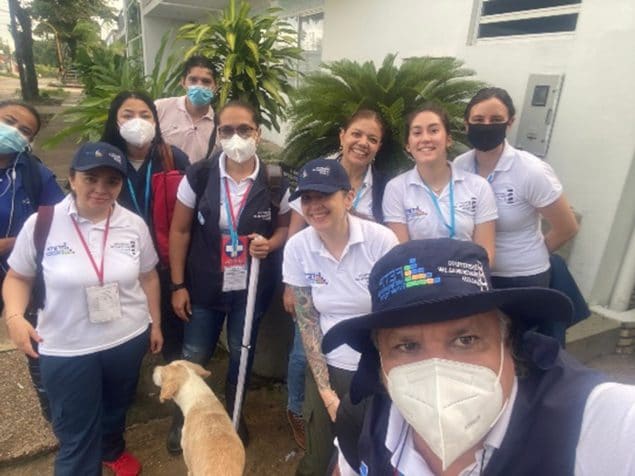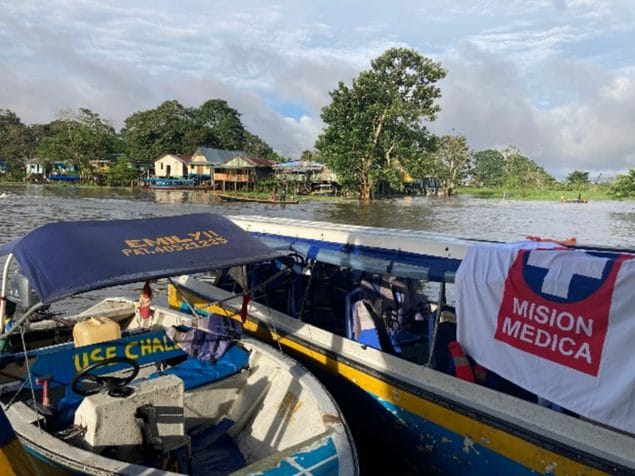Innovating Border Health Strategies by Engaging Mobile Communities in Colombia
Since 2015, a broad and sustained influx of immigration has impacted Colombia and its health sector. CDC’s Global Border Health Team (GBHT) in the Division of Global Migration Health collaborated with Colombia’s Institute of National Health (INS), a flagship National Institute of Public Health in the region, and Colombia’s Field Epidemiology Training Program (FETP) to strengthen border health capacity while recognizing the influx of immigration. With technical support from GBHT, Colombia’s health institutions implemented community-level work to understand migration patterns within Colombia and across the region to address the health risks that these migration patterns present to its population.

CDC staff, FETP residents, and FETP supervisors from Colombia and Brazil prepare to travel to border communities to conduct focus group discussions.
Colombia shares land borders with five countries (Panama, Venezuela, Brazil, Ecuador, and Peru). As the bridge between South America and Central America, Colombia serves as a route for migrants moving northward to Central America and the United States. Additionally, migrants from Venezuela stay in Colombia and also travel through Colombia to reach other countries in Latin America. Some Venezuelan migrants return to Venezuela and engage in regular cross-border movement into Colombia.
A New Way to Analyze Population Movement and Improve Border Health
Because dynamic and diverse migration patterns exist along Colombia’s borders, understanding population movement is essential to minimizing disease transmission between countries in this region. INS used GBHT’s Population Connectivity Across Borders toolkit (PopCAB) to analyze population movement. PopCAB enables officials to characterize population movement patterns to create maps and thematic reports using information from focus group discussions (FGD) and participatory mapping sessions with local leaders and key partners.
Beginning in October 2021, GBHT facilitated various in-person, virtual, and hybrid (virtual and in-person) training-of-trainers events on how to use PopCAB in Colombia. Collaborations between GBHT, INS, and Colombia’s FETP led to more than 60 public health officials receiving PopCAB training. During the trainings, participants conducted practice FGD with relevant stakeholders. Participants also used GBHT’s study guides to create and analyze qualitative and spatial datasets from the discussion notes and mapping exercises. Leadership from Colombia INS invited FETP residents from Brazil, Peru, and Ecuador to join the trainings. These residents supported facilitating in-person field implementation activities in communities along their country’s shared border with Colombia.

FETP Residents traveled by boat to carry out focus group discussions with indigenous community leaders in Leticia, Amazonas, Colombia on the triple border between Colombia, Peru, and Brazil.
In late March of 2022, GBHT observed the pilot sessions in which FETP residents used PopCAB to gather information on movement into, within, and out of Colombia. FGDs took place in and around Leticia, a border town in Colombia on the triple border with Peru and Brazil. The participants included a variety of stakeholders, such as indigenous community leaders and officials from non-governmental organizations that work with mobile populations. During this activity, FETP graduates and residents, including representatives from the Brazil and Peru FETP programs, helped facilitate field activities. INS complemented this activity with a Knowledge, Attitudes and Practices (KAP) survey in the local community.
Following the activity in Leticia, INS prioritized implementing PopCAB and KAP surveys in Cúcuta, Colombia, located on the border with Venezuela, to study the unique migration patterns of Venezuelans entering Colombia. INS concluded their project by implementing PopCAB field activities and KAP surveys in the Department of Putumayo on the country’s shared borders with Ecuador and Peru. This third border region in Putumayo has a substantial migration flow of Venezuelans. INS plans to use PopCAB and KAP survey findings from all three locations to inform public health interventions focused on mobile populations. “For this exercise, it was necessary to adjust the data collection tool to each prevailing border and culture. This process helps determine the regular and irregular migration routes, the migrant population [and] the reasons for migration to provide elements for decision making [translation from Spanish],” said Dr. Maritza, coordinator of the Colombia FETP.
Dr. Maritza added, “At the moment, this implementation exercise has generated tools for decision-making in the border municipalities, which were prioritized by the INS and FETP Colombia team. It has also created skills for the FETP residents, such as communication with ethnic and migrant population groups, teamwork under pressure, empathy with their peers, among others [translation from Spanish].”
The Future of Population Movement Analysis in Public Health Practice
Colleagues from multiple levels at INS and Colombia FETP have since initiated additional projects to continue to study population movement and extend what they have learned to their regional counterparts. In May of 2022, Colombia and Ecuador FETP residents teamed up and wrote a project proposal to cascade PopCAB trainings to additional Ecuadorian colleagues and co-implement PopCAB along their shared border. Their proposal was selected and funded through a small grant within GBHT’s Cooperative Agreement with the Training Programs in Epidemiology and Public Health Interventions Network (TEPHINET). The residents completed and presented the findings of their projects on September 30, 2022.
“The experience with the PopCAB toolkit implementation has made it possible to acquire knowledge and to strengthen skills in qualitative research and in the use of georeferencing methods for the FETP [residents] being trained and for tutors. Getting closer to the communities, government organizations, volunteers, and other key actors, provides more sensitivity to the situations for decision-making. It makes it possible to see and hear their own descriptions of the experiences, their difficulties, and health risks the migrant populations face once they start their journey [translation from Spanish],” said Dr. Maritza.
Additionally, INS partnered with Colombia’s Institute for Health Technology Assessment (IETS) to design two border health manuals, one of which includes information on understanding population mobility. These manuals will be published online and made available to Spanish-speaking public health officials across South America.
After nearly two years of collaboration to strengthen border health capacity between INS, Colombia FETP, GBHT, and TEPHINET, understanding population mobility patterns proves key to addressing public health needs among mobile populations and their host communities. This partnership has a regional impact and illustrates the region’s highly collaborative border health initiatives.